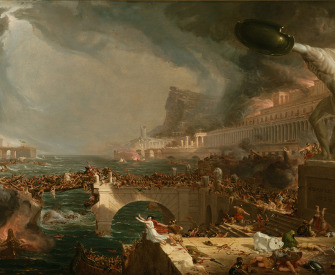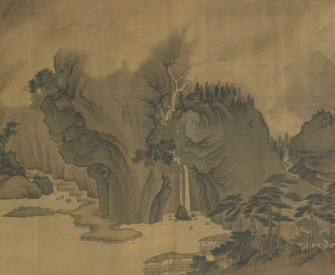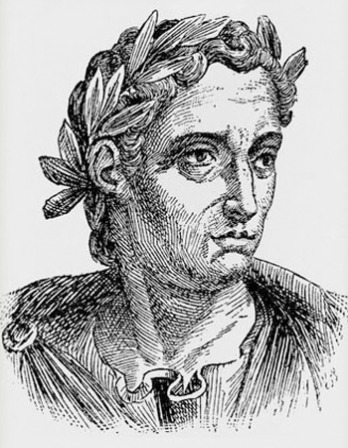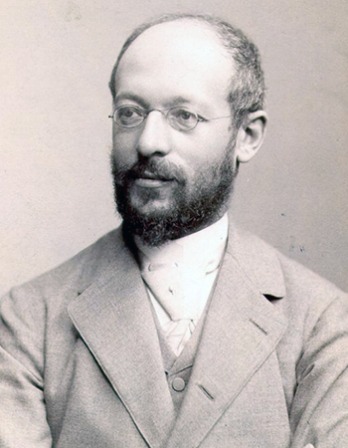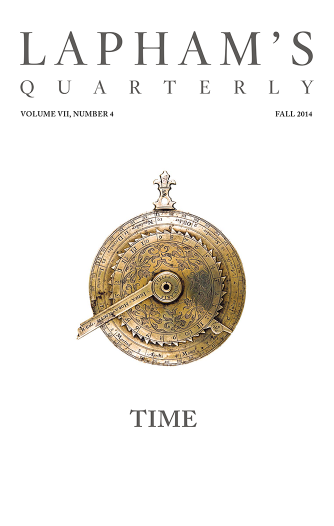I learned to make my mind large, as the universe is large, so that there is room for paradoxes.
—Maxine Hong Kingston, 1976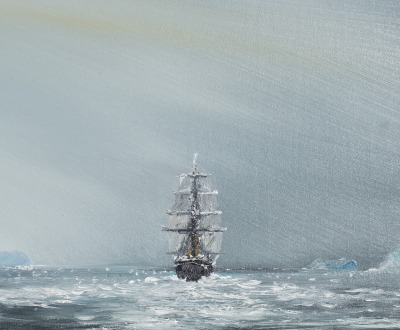
Discovery En Route to Antarctica (detail), by Vincent Alexander Booth, 2014. © Private Collection / Bridgeman Images.
Evolution has arranged that we take pleasure in understanding—those who understand are more likely to survive.
—Carl Sagan
I’m sorry I know so little; I’m sorry we all know so little. But that’s kind of the fun, isn’t it?
—Vera Rubin
A probable contender for a Nobel Prize at the age of eighty-one, Vera Rubin had been asked if she was troubled by the near-infinite expanse of human ignorance. The question was not gratuitous. Rubin’s eminence as an astronomer rested on her finding in the universe five, maybe ten times the mass of energy dreamed of in the cosmologies of Albert Einstein and Max Planck. Not only was the universe more infinite than previously imagined, but the newly discovered bulk of it was composed of dark matter destined to remain unknowable because not formed of the same atomic fairy dust as all things animal, mineral, and vegetable, celestial and terrestrial, to which mankind gives the names of nature ceaselessly creating itself.
To Rubin’s examiners, the discovery of a never-to-be-seen abyss was news unfit for man, machine, or beast. Was the dear lady not aghast? She was not. To the contrary. She stands in awe of her unknowing as if in Xanadu before the stately pleasure dome of Kubla Khan, where runs the sacred river Alph through caverns measureless to man, down to a sunless sea. Isn’t that kind of the fun, the looking into the vast darkness ripe with wonders that will never cease? The limitless expanse of human ignorance Rubin sees as the fortunate provocation that rouses out the love of learning, kindles the signal fires of the imagination. We have no other light with which to see and maybe to recognize ourselves as human.
The pleasure in the undertaking is the impassioned will to understand that embarks Darwin on his voyage to the Galápagos, prompts Shakespeare to write the plays, and in this issue of Lapham’s Quarterly urges the searchers for signs of life to venture into the morass of history, wander the roads of science, religion, and philosophy—Marie Curie sifting pitchblende in a Parisian storage shed, Seneca mapping a field of stars, Claude Lévi-Strauss collecting native myths in Brazil. At no matter what degree of latitude or longitude, the excitement is the act of discovery. Not the numbering and storing of the dots, but rather the connecting of the dots in what Leibniz conceived as a “preestablished harmony,” the suddenly seen things that were always there, allowing Simone Weil, twentieth-century philosopher, to regard “the entire universe” as “a great metaphor.”
Which is how it appeared to Alexander von Humboldt, nineteenth-century natural scientist and visionary explorer, who recognized planet Earth as one great living organism “animated and moved by inward forces.” His voluminous notes and observations (of trees and toads and ocean currents, of glaciers, birds, and ecosystems) preview by 150 years the sight of earth from space in 1968 awakening the nations of the earth to the state of environmental consciousness that supports the hope for the survival of human civilization.
Humboldt was a Prussian aristocrat educated as a young man in Jena and Weimar by Johann Wolfgang von Goethe, who directed his reading and lines of laboratory experiment. At the age of twenty-nine in 1799, accomplished as a botanist and zoologist, equipped with a knowledge of geology, history, and astronomy, Humboldt set forth on a five-year exploration of the Americas. Armed with reference books and intent upon perceiving “the connections between the physical and the intellectual worlds,” he brought with him “precise instruments” (barometer, hydrometer, artificial horizon) to measure, among other things, the variable intensity of magnetic forces, “the periodical oscillations of the aerial oceans,” the blueness of the sky. In the jungles and mountains of New Granada and Peru, the investigation’s mules were burdened with “forty-two boxes containing an herbal of six thousand equinoctial plants, seeds, shells, and insects, and geological specimens” gathered from the banks of the Amazon and on the ascent of Chimborazo, the volcano then regarded as the highest mountain in the world.
The climb in 1802 was arduous and slow; at seventeen thousand feet above sea level, the air is thin and no birds sing. Humboldt finds it hard to breathe, and his feet begin to bleed; but when he recalls the predicament ten years later in his Personal Narrative, he doesn’t dwell on the “unbelievable difficulties…quite unknown in the wildest parts of Europe.” He is surprised instead by joy, by the beauty of the landscape, and by the pleasure he takes in seeing how the vegetation changes with the topography—palms and bamboo forests at lower elevations, above them conifers and oaks, higher up lichens like those seen within the Arctic Circle. Although careful to mark the dots (the shape of a leaf, the layering of a rock), what delights him are the dots going together across otherwise unbridged distances in space and time. He draws upon his ferocious memory and love of learning to see the botanical specimen in his hand in the Andes similar to the one seen in his hand at the same altitude in the Alps. The scrupulously repeated making of similar connections—between the here and now with the there and then—leads him to a notion of the planet bound up in intertwining chains of being as fragile as they are beautiful, mortal and therefore analogous to the life and story of man:
The discovery of a new genus seemed to me far less interesting than an observation on the geographical relations of plants, or the migration of social plants, and the heights that different plants reach on the peaks of the cordilleras.
At the instigation of metaphor, Humboldt discovers a new way of looking at the earth, and over the course of the next fifty years he publishes a Promethean abundance of further notes, books, maps, letters, directing the thought not only of Goethe but also that of Henry David Thoreau and Charles Darwin, who says that without Humboldt, he never would have boarded the Beagle or written On the Origin of Species.
As diligently as Humboldt counts seeds and collects insects, and as rigorous his scientific methods of investigation, he believes that a great part of man’s response to the natural world must be based on the senses and the emotions. The sentiment places him in the vanguard of the nineteenth-century Romantic movement rising in objection to the Enlightenment view of the universe as a cleverly, if inexplicably, manufactured clock, its workings immutable and heartless, faithful in its service to the holders of property, the claimants of privilege, the custodians of bourgeois church and state and bank. Contemporary in age and spirit with Napoleon Bonaparte, Thomas Paine, and Ludwig van Beethoven, Humboldt climbed Chimborazo in the same year, 1802, that Samuel Taylor Coleridge and William Wordsworth published an expanded edition of Lyrical Ballads with a manifesto proclaiming a new world order:
We have no knowledge, that is, no general principles drawn from the contemplation of particular facts, but what has been built up by pleasure and exists in us by pleasure alone…the knowledge both of the poet and the man of science is pleasure…poetry is the first and last of all knowledge—it is as immortal as the heart of man.
A motion seconded, and if I read him right, so moved, by Albert Einstein. I derive the inference from the speech Einstein delivers in 1918 in celebration of Max Planck’s sixtieth birthday—Planck, whose coming upon quantum theory in 1900 creates the entire universe of modern physics. Unable to explain what prompted Planck to the discovery, Einstein finds “no logical bridge between phenomena and their theoretical principles,” only “intuition, resting on sympathetic understanding of experience.” He backs up his best guess with a variation on the general theory of relativity:
Man tries to make for himself in the fashion that suits him best a simplified and intelligible picture of the world; he then tries to some extent to substitute this cosmos of his for the world of experience, and thus to overcome it. This is what the painter, the poet, the speculative philosopher, and the natural scientist do…Each makes this cosmos and its construction the pivot of his emotional life, in order to find in this way the peace and security he cannot find in the narrow whirlpool of personal experience.

Autopsy of the First Crocodile, Onboard, Upper Egypt, by Ernest Benecke, 1852. Benecke’s amateur photographs, taken while on a grand tour of Egypt and the Mediterranean, arguably make him the world’s first ethnographic photographer. The Metropolitan Museum of Art, Gilman Collection, Purchase, William Talbott Hillman Foundation Gift, 2005.
My own simplified and intelligible pictures of the world I learned at an early age to make with the shape and sound of words. By the time I was six I had discovered the pleasure in reading, finding in books the peace and security of membership in realities other than those confined to my experience at home and school in San Francisco’s Pacific Heights. It wasn’t long before I understood the relation between reader and writer that Alberto Manguel, Canadian essayist and once-upon-a-time reader to Jorge Luis Borges, attributes to their being joined at birth on a Mesopotamian clay tablet three millennia before the birth of Christ. The first cuneiform incision is the invention of the art of writing, but the mark is dark matter until illuminated by the art of reading. The reader creates the writer, the writer creates the reader; between them they construct a cosmos that suits them best, and by so doing they overcome, in Manguel’s words, “the obstacles of geography, the finality of death.” Their joint enterprise is the making of the two worlds we inhabit as human beings, one in the flesh, the other in mind. Man, says Thomas Carlyle, is symbol maker made conscious of himself as symbol maker, the only one of earth’s creatures (or at least the only one we know about) capable of traveling in time in a cosmos that suits him. “The past,” said William Faulkner, “is never dead. It’s not even past.” The observation is in line with George Orwell’s dictum “Who controls the past controls the future; who controls the present controls the past.” Orwell was talking about the use of history as propaganda bent to the service of the state. The better deployment is in the service of the individual—the velocity of light relative to the mass of energy in the head of an observer.
It isn’t with miracles that men make their immortality. They do so with the vast store of human consciousness gathered on their travels across the frontiers of the millennia, navigational lights flashing across the gulf of time on scraps of papyrus and scratchings in stone, on ships’ logs and bronze coins, as epic poems and totem poles and painted ceilings, in confessions voluntary and coerced, in five-act plays and three-part songs.
“Read to live,” says Flaubert somewhere in his letters, and where else does one live if not in a house of straw, signs, and symbols made from the shaping and reshaping of a once-upon-a-time. History is a record of event (kingdoms lost and battles won, cities built and churches burned), but it is also the compost heap of human civilization; the finding of the present in the past, the past in the present, is the stuff of which our lives, our liberties, and pursuits of happiness are made.
Books I regard as voyages of discovery, and with an author whom I admire, I gladly book passage to any and all points of view or destination—Philadelphia in 1776, Rome during the lives of the Caesars, Berlin and Hollywood in the 1920s. I don’t go in search of the lost gold mines of imperishable truth; I look instead for where I might learn what it is to be a human being, as flesh made word and word made flesh, as man, as woman, as both, or none of the above.
Usually I read four or five books at the same time, preferably in the company of authors on the front lines of different centuries (with John Donne and John le Carré in London, with Molière and Balzac in Paris), and in books I’ve read more than once, I encounter marginalia reaching back ten or twenty or fifty years and written while traveling in cities as unlike one another as Chicago and Havana. I live in all the pasts present on the page, and I begin to understand what the physicists have in mind when they talk about the continuum of time and space.

The Progress of the Century—The Lightning Steam Press, the Electric Telegraph, the Locomotive, the Steamboat, by Currier and Ives, 1876. The Metropolitan Museum of Art, bequest of Adele S. Colgate, 1962.
No matter its origin or form, all writing—poem, play, mathematical equation, arrest warrant, novel, headline, history, tax receipt, chemical formula, essay—is the telling of a story. Some stories are immortal, others incoherent. Homer told a story; so do Donald Duck and Donald Trump. The stories that bear a second reading are those in which the author manages to get at the truth of what he or she has seen, felt, thought, knows, can find language to express. The task is never easy, but it is the labor of the writer’s observation turned by the wheel of the reader’s imagination that seeds the fertile ground in Xanadu, “where blossomed many an incense-bearing tree,” from which mankind gathers its common stores of energy and hope.
Some years ago, on its editorial page, the New York Times handed down the ruling that “great publications magnify beyond measure the voice of any single writer.” The sentence employed the wrong verb. The instruments of the media amplify a voice, serving the same purpose as a loudspeaker in a ballpark or a prison. What magnifies a voice is the force of mind and its power of expression, which is why Shakespeare’s plays still draw a crowd in Central Park, why in any given year more people crowd through the doors of America’s museums than fill the seats in all of the country’s sports arenas. The old pictures on the walls tell a story they can see to be their own.
When I was ten, I delighted in the act of writing, at twelve in the expecting that by the time I turned twenty-one I would know how to make of it an art. Before I was thirty I’d written seven drafts of a first novel mercifully unpublished; I consoled myself with the thought that by the time I was forty, I would know what I was doing. I didn’t. When I was forty-five, I began to explore the uses of the essay, borrowing the approach from Michel de Montaigne, sixteenth-century French scholar and contemporary of Shakespeare and Cervantes, who looked to escape the “tedious idleness” and “disagreeable company” in the narrow whirlpool of his personal experience with the verb essayer, to try, to attempt, to embark upon. Like Vera Rubin, he stands in awe before the blank page of his near-limitless ignorance, asking himself at the outset of his reflections, whether on cannibals or the custom of wearing clothes, What do I know?
One doesn’t discover new lands without consenting to lose sight of the shore for a very long time.
—André Gide, 1926His question distinguishes the essay from the less adventurous forms of expository prose—the dissertation, the polemic, the op-ed, the campaign speech, the annual report, the hotel bill. Writers disposed to render a judgment, swing an election, or cast a moneylender out of the temple begin the first paragraph knowing how, when, where, and why they intend to claim the privilege of the last word. Not so the essayist, even if what he or she is writing purports to be a history or a field report. Like Twain’s Huckleberry Finn, the essayist lights out for the territory, never sure of what he hopes or means to say until in the next sentence the words show up as a surprise. Which is kind of the fun, happily noted by Humboldt’s student Ralph Waldo Emerson, “When the mind is braced by labor and invention, the page of whatever book we read becomes luminous with manifold allusion.”
This issue of Lapham’s Quarterly suggests that we do nobody any favors by outsourcing the acts of discovery to machines. The suggestion runs counter to the arrogant belief that machines are the salvation of the human race, technology the light and wonder of the world. The prophecy is false, but the sales promotion is relentless. The data-mining dwarfs in Silicon Valley praise the glories of artificial intelligence and the internet of things, talk about attaching a human consciousness to a computer that lives forever. The Pentagon recruits drones to wage and lose its wars, Wall Street hires bots to mint and spoil its money; in the nation’s schools, the curriculum known as STEM (science, technology, engineering, math) sweeps the classrooms clean of improvised literary devices, downgrades the study of history and the humanities because they don’t get along well with tests administered by computers. At our colleges and universities, the oracles in residence complacently assume that man’s machines have vanquished nature, commodified the tribes of Paleolithic instinct, will construct Elon Musk’s stairway to the stars. The humanities they construe as exquisite ornaments, meant to be preserved together with the alumni slush fund and naming opportunities, in the vaults of the endowment. Their piety recalls the lines of Archibald MacLeish:
Freedom that was a thing to use
They’ve made a thing to save
And staked it in and fenced it round
Like a dead man’s grave.
To bury the humanities in tombs of precious marble is to deny ourselves the pleasure that is the love of learning and the play of the imagination, and to cheat ourselves of the inheritance alluded to in Goethe’s observation that he who cannot draw on three thousand years is living hand to mouth. Technology is the so arranging of the world that it is the thing that thinks and the man who is reduced to the state of a thing. Machine-made consciousness, man content to serve as an obliging cog, is unable to connect the past to the present, the present to the past. The failure to do so breeds delusions of omniscience and omnipotence, which lead in turn to the factories at Auschwitz and the emptiness of President Donald Trump.
Our technologies produce continuously improved means toward increasingly ill-defined ends. We have acquired a great many new weapons and information systems, but we don’t know at what or at whom to point the digital enhancements. For direction to the “peace and security” of a cosmos that suits us best, we are better advised to look, as did Albert Einstein, to “the painter, the poet, the speculative philosopher, and the natural scientist” than to the economist, the cosmetic surgeon, and the engineer.

Vanitas Still Life, by Edwaert Collier, 1662. The Metropolitan Museum of Art, Purchase, 1871.
Machines can measure blood flow and scan a heartbeat, but they don’t know how it is with man, who he is and how it is between him and other men. Data streams can number and store the dots in the EKG and the ATM, hook up assignations with Tinder and fix the trades for Goldman Sachs. But they can’t connect the dots to anything other than themselves. Watson and Siri can access the Library of Congress, but they can’t read books. Machines don’t do metaphor. They process words as lifeless objects, not as living subjects, and so they don’t know what the words mean. Not knowing what the words mean, they can’t hack into the civilizing heap of human consciousness (of myth and memory and emotion) that is the making of ourselves as human beings.
The internet is maybe the best and brightest machine ever made by man, blessed with a near-infinite expanse of miraculous application. Language is not yet one of them. Computers scan everything but hear nothing. Even if they knew where to find or how to make a cosmos best suited for human habitation, how would they send word of the discovery? They know not who they are or what they do.
The strength of language doesn’t consist in its capacity to pin things down or sort things out. “Word-work,” said Toni Morrison, accepting the Nobel Prize in Literature in 1993, “is sublime…because it is generative,” its felicity found in its reach toward the ineffable. “We die,” she said. “That may be the meaning of life. But we do language. That may be the measure of our lives.” Shakespeare shaped the same thought as a sonnet, comparing his beloved to a summer’s day, offering his rhymes as surety on the bond of immortality—“So long as men can breathe or eyes can see / So long lives this and this gives life to thee.”
Google can bring the news that E=mc2, but Google doesn’t know what E is. Doesn’t know that in the first of its many meanings, E is the mind of man (nature looking creatively back on itself) embarking on the voyages of discovery—Odysseus, great-hearted and wide-wandering on the wine-dark sea, Charles Darwin sailing for the enchanted islands in the Galápagos, Humboldt climbing Mount Chimborazo, Michelangelo reaching upward toward the horizon of the Sistine ceiling, deaf Beethoven directing the performance of his Ninth Symphony in Vienna in 1824, giving voice to the joy of learning that wonders never cease.
Click here to listen to an audio version of this essay read by Lewis Lapham.
